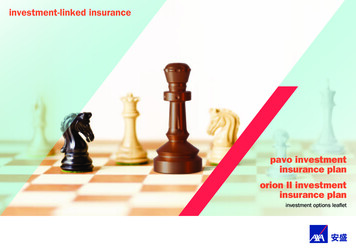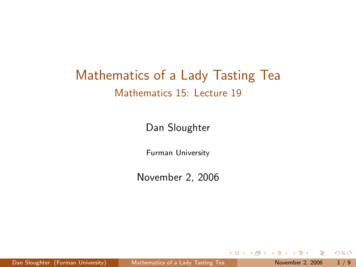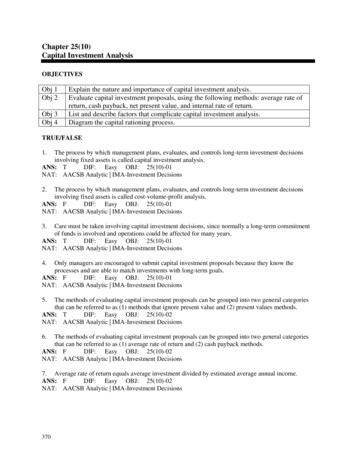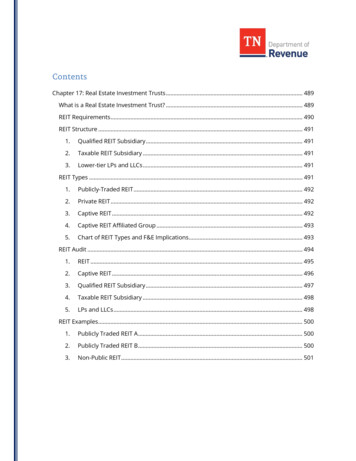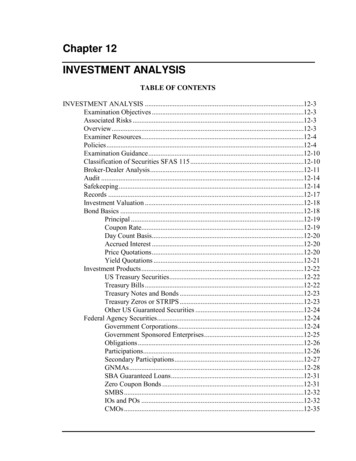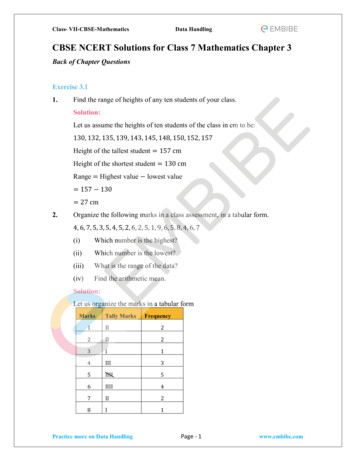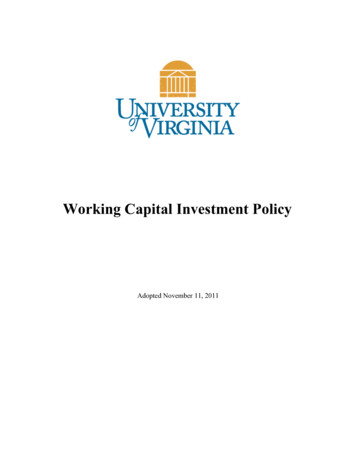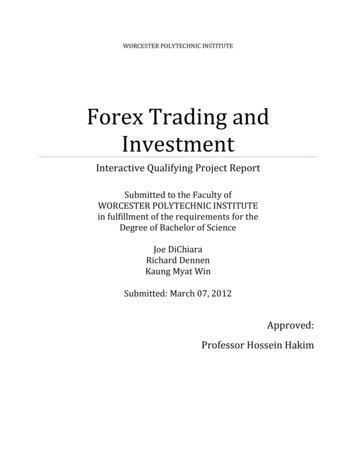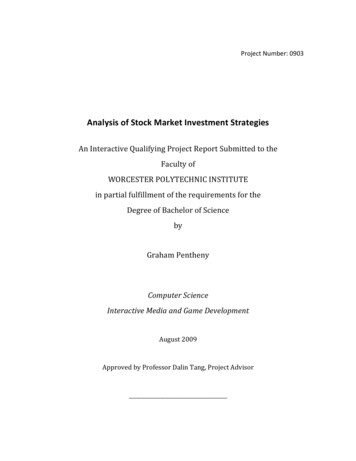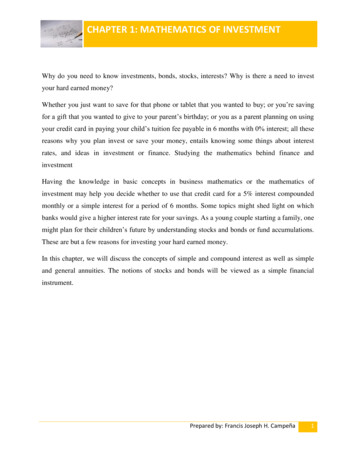
Transcription
CHAPTER 1: MATHEMATICS OF INVESTMENTWhy do you need to know investments, bonds, stocks, interests? Why is there a need to investyour hard earned money?Whether you just want to save for that phone or tablet that you wanted to buy; or you’re savingfor a gift that you wanted to give to your parent’s birthday; or you as a parent planning on usingyour credit card in paying your child’s tuition fee payable in 6 months with 0% interest; all thesereasons why you plan invest or save your money, entails knowing some things about interestrates, and ideas in investment or finance. Studying the mathematics behind finance andinvestmentHaving the knowledge in basic concepts in business mathematics or the mathematics ofinvestment may help you decide whether to use that credit card for a 5% interest compoundedmonthly or a simple interest for a period of 6 months. Some topics might shed light on whichbanks would give a higher interest rate for your savings. As a young couple starting a family, onemight plan for their children’s future by understanding stocks and bonds or fund accumulations.These are but a few reasons for investing your hard earned money.In this chapter, we will discuss the concepts of simple and compound interest as well as simpleand general annuities. The notions of stocks and bonds will be viewed as a simple financialinstrument.Prepared by: Francis Joseph H. Campeña1
CHAPTER 1: MATHEMATICS OF INVESTMENT1.1 Simple InterestIn financial transactions an interest is the amount paid by a borrower to a lender for theuse of money over a period. Interest that is paid as a percent of amount borrowed or invested iscalled simple interest. The formula for simple interest is given by the following:Simple Interest𝐼 𝑃𝑟𝑡Where,𝐼𝑠 𝑖𝑛𝑡𝑒𝑟𝑒𝑠𝑡 𝑒𝑎𝑟𝑛𝑒𝑑 (𝑜𝑤𝑒𝑑)𝑃 𝑝𝑟𝑖𝑛𝑐𝑖𝑝𝑎𝑙 𝑎𝑚𝑜𝑢𝑛𝑡 𝑖𝑛𝑣𝑒𝑠𝑡𝑒𝑑 (𝑜𝑟 𝑏𝑜𝑟𝑟𝑜𝑤𝑒𝑑)𝑟 𝑎𝑛𝑛𝑢𝑎𝑙 𝑟𝑎𝑡𝑒 𝑜𝑓 𝑖𝑛𝑡𝑒𝑟𝑒𝑠𝑡𝑡 𝑡𝑒𝑟𝑚 𝑜𝑟 𝑡𝑖𝑚𝑒 𝑓𝑟𝑎𝑚𝑒 𝑖𝑛 𝑦𝑒𝑎𝑟𝑠Example 1. Suppose Kiko wanted to invest an amount 𝑃ℎ𝑝 50,000.00 for 2 years at a financialinstitution that gives a simple interest of 3% per year. The interest rate was given to Kiko by thefinancial institution on the assumption that he cannot withdraw the investment within the 2-yearperiod. How much is Kiko’s earning on the investment after the 2-year period?Solution:The following can be obtained from the problem: P 50,000 , r 0.03 , t 2 .I Pr t 50,000 0.03 2 3,000 . From this we conclude that, the investment earned𝑷𝒉𝒑𝟑, 𝟎𝟎𝟎. 𝟎𝟎.Prepared by: Francis Joseph H. Campeña2
CHAPTER 1: MATHEMATICS OF INVESTMENTInterest can be viewed as a lender or a borrower. Sometimes if we are the investor, we considerthe value of our investment after a given period. In this case we introduce the concept of futurevalues or accumulated values or maturity value.Future Value𝐹 𝑃 𝐼𝑠𝐹 𝑃(1 𝑟𝑡)Where,𝐼𝑠 𝑖𝑛𝑡𝑒𝑟𝑒𝑠𝑡 𝑒𝑎𝑟𝑛𝑒𝑑 (𝑜𝑤𝑒𝑑)𝑃 𝑝𝑟𝑖𝑛𝑐𝑖𝑝𝑎𝑙 𝑎𝑚𝑜𝑢𝑛𝑡 𝑖𝑛𝑣𝑒𝑠𝑡𝑒𝑑 (𝑜𝑟 𝑏𝑜𝑟𝑟𝑜𝑤𝑒𝑑)𝑟 𝑎𝑛𝑛𝑢𝑎𝑙 𝑟𝑎𝑡𝑒 𝑜𝑓 𝑖𝑛𝑡𝑒𝑟𝑒𝑠𝑡𝑡 𝑡𝑒𝑟𝑚 𝑜𝑟 𝑡𝑖𝑚𝑒 𝑓𝑟𝑎𝑚𝑒 𝑖𝑛 𝑦𝑒𝑎𝑟𝑠Example 2. April wants to borrow 𝑃ℎ𝑝40, 000.00 from a bank that gives an annual interest rateof 4.5%. However, she only wants to borrow the fund for a 9-month period and will be able topay the bank immediately after 9 months. How much interest is she going to pay from borrowingthe amount of money? What is the accumulated value of the amount borrowed after the 9-monthperiod?Solution:The following can be obtained from the problem: P 40,000 , r 0.045 , t 0.75 since she onlyborrowed the fund for 9-months which is ¾ of a year.I s Pr t 40,000 0.045 0.75 1,350 . From this we conclude that, the interest due is𝑷𝒉𝒑𝟏, 𝟑𝟓𝟎. 𝟎𝟎.Prepared by: Francis Joseph H. Campeña3
CHAPTER 1: MATHEMATICS OF INVESTMENTIn this example the accumulated value of the amount borrowed is 𝐹 𝑃 𝐼𝑠 that is; the sum ofthe principal amount or the amount borrowed and the interest. Thus, after nine months, April willpay the bank 𝑷𝒉𝒑 𝟒𝟏, 𝟑𝟓𝟎. 𝟎𝟎Example 3. What is the simple interest rate applied if an investment of Php37,500 accumulatesto Php41,812.5.00 in the period of 5 years?Solution:We note that the interest earned by the investment is Php4312.5 that is, I 4312 .5 . From theformula I Pr t , we have r I4,312 .5 0.023 2.3%Pt 37,500 5 Example 4. The repayment on a loan was Php16,275. If the loan was for 15 months or 1.25years at 6.8% interest a year, how much was the principal?Solution:Based from the given we have the following: F 16,275 , r 0.068 , and t 1.25Since F P 1 rt , we have P F16,275 15,000 . 1 rt 1 0.068 1.25 Prepared by: Francis Joseph H. Campeña4
CHAPTER 1: MATHEMATICS OF INVESTMENTDifferent ways of expressing time/term of a loan or investment.Sometimes the term of investment is not given in years. The term or time frame given incertain problems maybe stated in days or months. In cases where the time is expressed in monthsit is easy to express it in years. But when the term/time is given in days we use a time factor suchas the following:𝐴𝑐𝑡𝑢𝑎𝑙 𝑡𝑖𝑚𝑒360Ordinary Simple Interest or Bankers Rule𝐴𝑐𝑡𝑢𝑎𝑙 𝑡𝑖𝑚𝑒365Exact Simple �� �𝑎𝑡𝑒 𝑡𝑖𝑚𝑒365Actual time – Number of days until the repayment date except the origindate.Approximate time – Assumes that every month contains 30 days.RemarkThe Bankers Rule or Ordinary Simple Interest is applied whenever a givenproblem does not specify the time factor to be used.Example 5. Find the actual and approximate time from May 1, 1983 to September 15, 1983.Actual TimeMayJuneJulyAugSept303031311513731-1 30Approximate TimeMayJuneJulyAugSept293030301513430-1 29Prepared by: Francis Joseph H. Campeña5
CHAPTER 1: MATHEMATICS OF INVESTMENTExample 6. Find the actual and approximate time from April 15, 2008 to December 21,2008.Actual 302125030-15 15Approximate 302124630-15 15Example 7. Find the actual and approximate time from June 25, 2008 to Nov 18, 2008.Actual TimeJuneJulyAugSeptOctNov5313130311814630-25 5Approximate TimeJuneJulyAugSeptOctNov5303030301814330-25 5Prepared by: Francis Joseph H. Campeña6
CHAPTER 1: MATHEMATICS OF INVESTMENTEXERCISES1. Determine the Actual and Approximate number of days in the given origin and repaymentdates.Origin DateRepayment DateAMay 22, 1995July 09, 1995BJanuary 06, 1997November 06, 1997CMarch 03, 2007October 11, 2007DFebruary 04, 1990November 05, 1992EMarch 02, 2005November 05, 2006Actual TimeApproximate Time2. Joseph borrowed 𝑃ℎ𝑝 5,000 on November 2, 2015 from Arthemus, which is to be repaid onMay 21, 2016 at 6.2% simple interest per year. Find the amount to be repaid. How much willthe interest be at the repayment date if the following time factors are used?a. Bankers Ruleb. Exact Simple ���3653. How much should Mark pay to Michele if he borrowed Php 10,000 on June 25, 2015 and ifthe principal and interest are to be paid on November 18, 2015 at 15% simple interest peryear? Use the following time factors.a. Bankers Ruleb. Exact Simple ���365Prepared by: Francis Joseph H. Campeña7
CHAPTER 1: MATHEMATICS OF INVESTMENT4. At what simple interest rate will a sum of money double itself in 5 years?5. If Wendy wants to invest her Php25,000, how many years will it take for her savings toaccumulate to Php 40,000 if she invested her savings to a financial institution that provides asimple interest rate is 4.5% per year?6. An amount of P12, 500 is invested at 3.25% simple interest for 3 years. Complete the tablebelow.Time (in years)PrincipalRateInterestFuture Value0P12, 5000.0325P0P07.W1hat2will3be thematurity value of P15, 500 if it is borrowed at 10.5% rate for 10 months?8. How much should Mrs. Dolores invest today in a time deposit with 5.5% interest if sheexpects to have P175, 000 for his son’s education at the end of 5 years?9. Mr. Pascual, an airline owner, decided to invest P2.5 million to fund his department handlingspare parts replacement. How long will it take his investment to accumulate to P3.325million if the bank’s interest rate is 5.5%?10. FJC Printing would like to invest a certain amount in a bank that will accumulate to P157,800 in 550 days for the replacement of a printer. If the bank offers 8% interest, how muchmust be invested at the start of the term under11. Use Banker’s Rule to compute the simple interest of P10, 000 investment at 10% simpleinterest rate from April 14, 2004 to November 18 of the same year.12. The university treasurer puts half a million pesos to a time deposit offering 7% for 2 years.How much is in the fund at the end of the term?13. What rate was applied to a 4-year loan of P278, 000 in which the maturity value is P372,520?Prepared by: Francis Joseph H. Campeña8
CHAPTER 1: MATHEMATICS OF INVESTMENT1.2 Compound InterestConsider an investment whose time frame is divided into equal intervals. If an interest iscomputed after an interval and is being added to the principal and thereafter earns an interest,then the difference between the original principal and the total amount after the whole timeframe is called compound interest. The compound amount or the accumulated value of theprincipal is the sum of the principal and the compound interest. In this situation, we see that theinterest is being converted into a principal and thus we use the phrase “interest is compounded”or “interest is converted”.Consider an investment amount 𝑃 place on a financial institution that gives a compound interestwhere the interest rate per conversion period is 𝑖. After one conversion, the total amount due tothe investor is 𝑃 𝑃𝑖. The new principal at the end of the first conversion is now 𝑃 𝑃𝑖 𝑃(1 𝑖). At the end of the second period, the accumulated value now becomes, 𝑃 𝑃𝑖 (𝑃 𝑃𝑖)𝑖 which is equivalent to 𝑃 𝑃𝑖 𝑃𝑖 𝑃𝑖 2 𝑃(1 𝑖)2 . Thus, the new principal afterthe second conversion is 𝑃(1 𝑖)2 . In a similar manner, at the end of the third period or thirdconversion, the accumulated value becomes 𝑃(1 𝑖)2 𝑃(1 𝑖)2 𝑖 𝑃(1 𝑖)2 (1 𝑖) 𝑃(1 𝑖)3 . Now, following the patterns that we see, after the 𝑛𝑡ℎ conversion, the accumulatedvalue becomes 𝑃(1 𝑖)𝑛 . Thus we have the following formula:Formula𝐹 𝑃(1 𝑖)𝑛Where,F compound amount or accumulated value of P at the end of the termP present value or original principalj interest rate per yeari interest rate per period𝒋𝒏 𝒕𝒎𝒊 n total number of conversions periods𝒎by: Francis Joseph H. CampeñaPreparedm number of conversions per yeart term9
CHAPTER 1: MATHEMATICS OF INVESTMENTIn the context of compound interest, the interest rate per annum or per year is called the nominalrate of interest. Thus when a given nominal rate is said to be compounded quarterly, that meansin a given year there will be 4 conversions. Similarly, when we say compounded monthly, theconversions are made every month therefore in a given year, there will be 12 conversions.Example Find the compound amount and interest:a. If Php 2,500 is invested at 13% compounded quarterly for 12 yearsSolutionGiven: 𝑃 2,500; 𝑗 13% ; 𝑡 12; 𝑚 4𝑛 𝑡𝑚 4 12 48𝑖 𝑗0.13 0.0325𝑚3𝐹 𝑃(1 𝑖)𝑛 2,500(1.0325)48 𝑷𝒉𝒑 𝟏𝟏, 𝟔𝟎𝟓. 𝟒𝟕b. If Php 3,700 is invested at 12% compounded semi-annually for 5 yearsSolutionGiven: 𝑃 3,700; 𝑗 12% ; 𝑡 5; 𝑚 2𝑛 𝑡𝑚 2 5 10𝑖 𝑗0.12 0.06𝑚2𝐹 𝑃(1 𝑖)𝑛 3,700(1.06)10 𝑷𝒉𝒑 𝟔, 𝟔𝟐𝟔. 𝟏𝟒Example Find the present value of Php 2,850 due in 5 years if money is worth 10%compounded quarterly.SolutionGiven: 𝐹 2,850; 𝑗 10% ; 𝑡 5; 𝑚 4Prepared by: Francis Joseph H. Campeña10
CHAPTER 1: MATHEMATICS OF INVESTMENT𝑛 𝑡𝑚 5 4 20𝑗0.1 0.025𝑚4𝐹𝑃 2,850(1.025) 20 𝑷𝒉𝒑 𝟏, 𝟕𝟑𝟗. 𝟐𝟕(1 𝑖)𝑛𝑖 Example How much must be invested today in a savings account to realize Php 9,000 in 4years, if money earns at the rate of 4% compounded quarterly?SolutionGiven: 𝐹 9,000; 𝑗 4% ; 𝑡 4; 𝑚 4𝑛 𝑡𝑚 4 4 16𝑗0.04 0.01𝑚4𝐹𝑃 9,000(1.01) 16 𝑷𝒉𝒑 𝟕, 𝟔𝟕𝟓. 𝟑𝟗(1 𝑖)𝑛𝑖 Example What rate compounded annually will double any amount principal if it is invested in 6years?SolutionLet 𝑥 be the amount to be invested. 𝑚 1; 𝑡 6 𝑛 6. We want to find j.𝑗 66𝐹 𝑃(1 𝑖) 2𝑥 𝑥 (1 ) 2 (1 𝑗)6 𝑗 2 1 𝒋 𝟏𝟐. 𝟐𝟓%1𝑛Example What nominal rate converted semi-annually will make Php 20,000 amount to Php50,000 in 8.5 years?SolutionPrepared by: Francis Joseph H. Campeña11
CHAPTER 1: MATHEMATICS OF INVESTMENTWe want to find j. Given: 𝑚 2; 𝑡 8.5 𝑛 17.𝑗 17𝑗 1717𝐹 𝑃(1 𝑖) 50,000 20,000 (1 ) 2.5 (1 ) 𝑗 2( 2.5 1)12𝑛 𝒋 𝟏𝟏. 𝟎𝟖%Example When will Php 30,000 earn interest of Php 15,000 if it is invested at the rate of7.5% converted annually?SolutionWe want to find t. Given: 𝐹 45,000; 𝑃 30,000 ; 𝑗 7.5%; 𝑚 1𝐹 𝑃(1 𝑖)𝑛 45,000 30,000 (1 0.075 𝑛) 1.5 (1 0.075)𝑛 𝑙𝑜𝑔1.51 𝑛𝑙𝑜𝑔(1.075)𝑛 𝑙𝑜𝑔1.5 𝑛 5.6065 𝒕 𝟓. 𝟔𝟎𝟔𝟓𝑙𝑜𝑔(1.075)Example . When will a principal double itself if the interest rate is 14% compoundedquarterly?SolutionWe want to find j. Given: 𝐹 2𝑃 ; 𝑗 14%; 𝑚 40.14 𝑛𝐹 𝑃(1 𝑖) 2𝑃 𝑃 (1 ) 2 (1.035)𝑛 𝑙𝑜𝑔2 𝑛𝑙𝑜𝑔(1.035)4𝑙𝑜𝑔2𝑛 𝑛 20.1488 𝒕 𝟓. 𝟎𝟑𝟕𝟐𝑙𝑜𝑔(1.035)𝑛Sometimes we may want to compare which interest rate would provide a higher interest whentheir interest payments are not the same. We then have to resort to converting these interest ratesto a common interest payment. This is the notion of effective rates of interest. For instance,which interest rate gives a higher interest for an investment of 1 Peso (Php1), an 8%Prepared by: Francis Joseph H. Campeña12
CHAPTER 1: MATHEMATICS OF INVESTMENTcompounded semi-annually or a 7.9% compounded monthly. If 1 peso is invested at a rate of 8%compounded semi-annually, then at the end of the year it accumulated to 𝑆 1 (1 0.08 22) 1.0816. While an investment of 1 peso at a rate of 7.9% compounded monthly accumulates to𝑆 1 (1 0.08 1212) 1.082999507.The effective rate of interest of 𝑖 compounded 𝑚 times a year can be computed as𝑟 (1 𝑖)𝑚 1ExampleDetermine the effective r
CHAPTER 1: MATHEMATICS OF INVESTMENT . or you’re saving for a gift that you wanted to give to your parent’s birthday; or you as a parent planning on using your credit card in paying your child’s tuition fee payable in 6 months with 0% interest; all these reasons why you plan invest or save your money, entails knowing some things about interest rates, and ideas in investment or finance .

